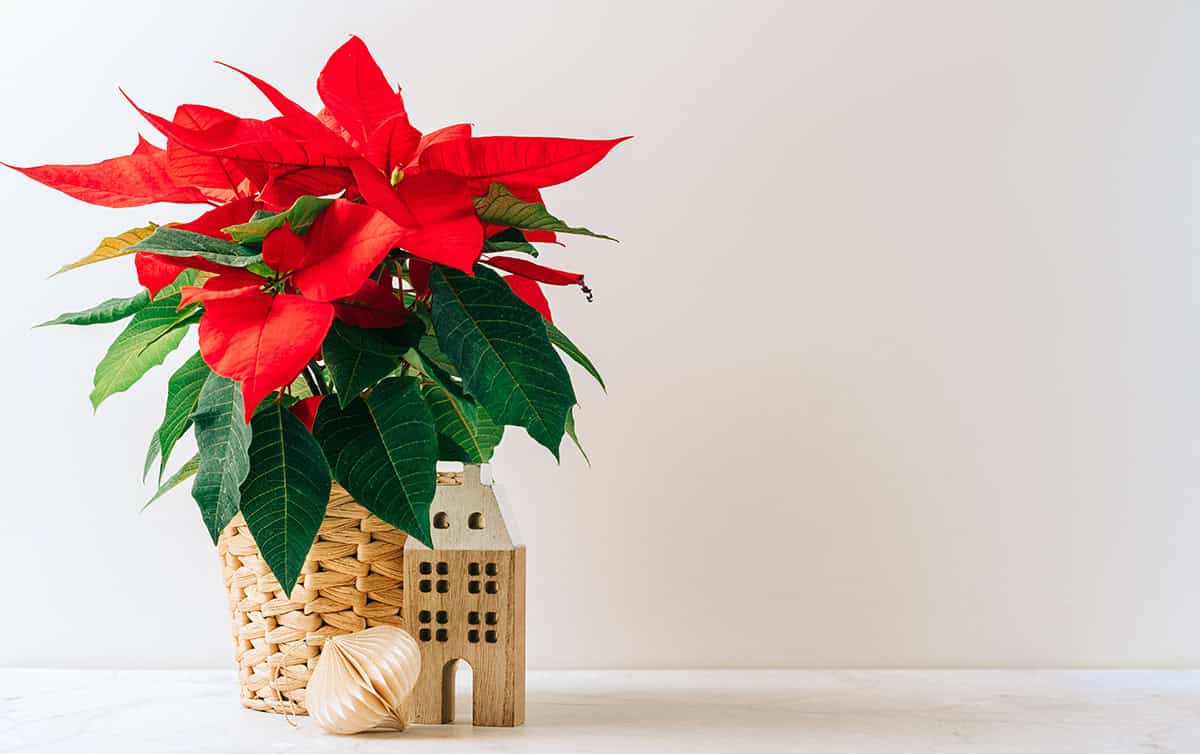It’s the holiday season, and your poinsettia’s vibrant red leaves are the centerpiece of your decorations. But once the festivities are over, you want to keep it healthy and beautiful. Discover how to care for your poinsettia year-round so it remains a stunning part of your home long after the holidays.
Table of Contents
What Does the Poinsettia Flower Symbolize?
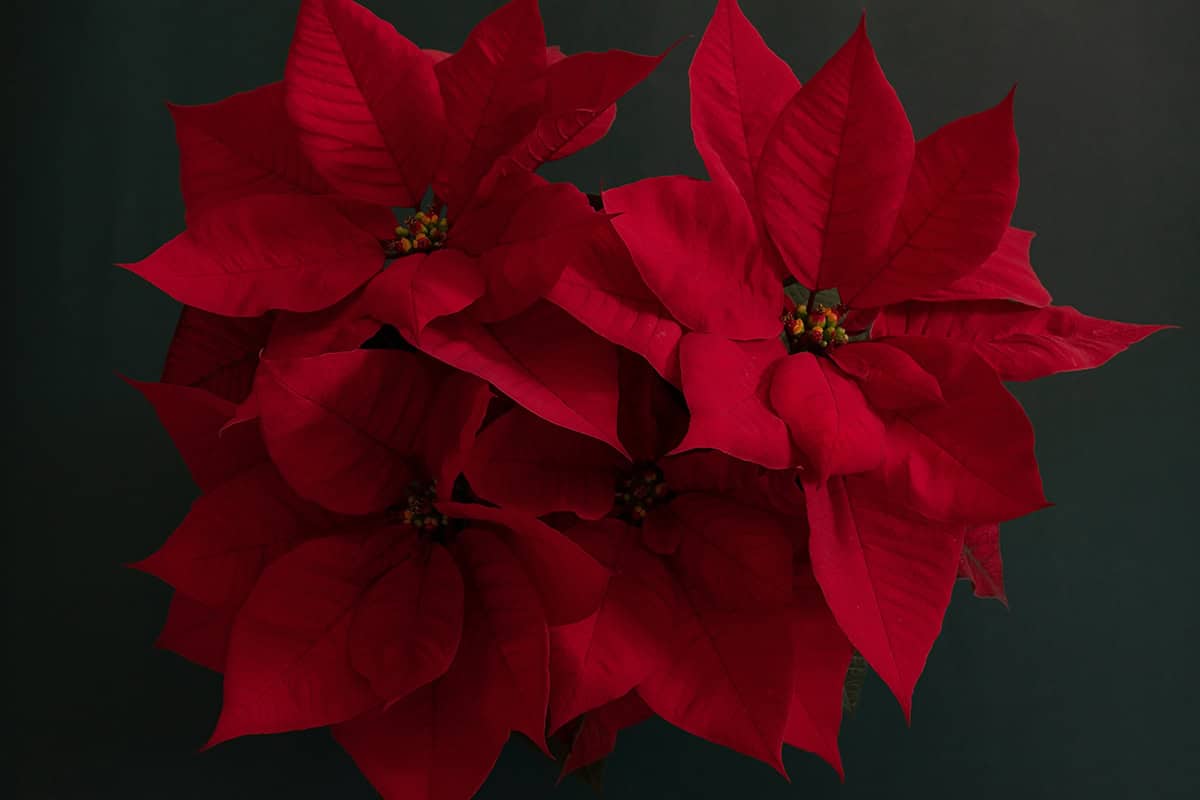
Poinsettias are widely known as the unofficial flower of the holiday season, but do you wonder about their symbolism? These vibrant flowers hold a cherished place in many homes across the United States during the winter months, with a fascinating history dating back to the ancient Aztecs.
Initially grown by the Aztecs, poinsettias were later adopted by 17th-century Franciscan priests who first connected the plant to Christmas festivities.
The poinsettia’s symbolism is deeply rooted in its red and green foliage, which is reminiscent of the Crucifixion of Jesus Christ. The red color represents the blood shed by Jesus on the cross, while the green leaves symbolize life, hope, and renewal. Moreover, the star-shaped form of the flower is said to represent the Star of Bethlehem, which guided the three wise men to Jesus’ birthplace.
Beyond their religious symbolism, poinsettias also convey feelings of joy, celebration, and festivity. With their wide range of colors like reds, pinks, purples, yellows, and more, these seasonal blooms can be found in many settings where people gather to commemorate special occasions. During the holiday season, poinsettias not only create a warm, welcoming atmosphere but also serve as a reminder of the true meaning behind the celebrations.
Light
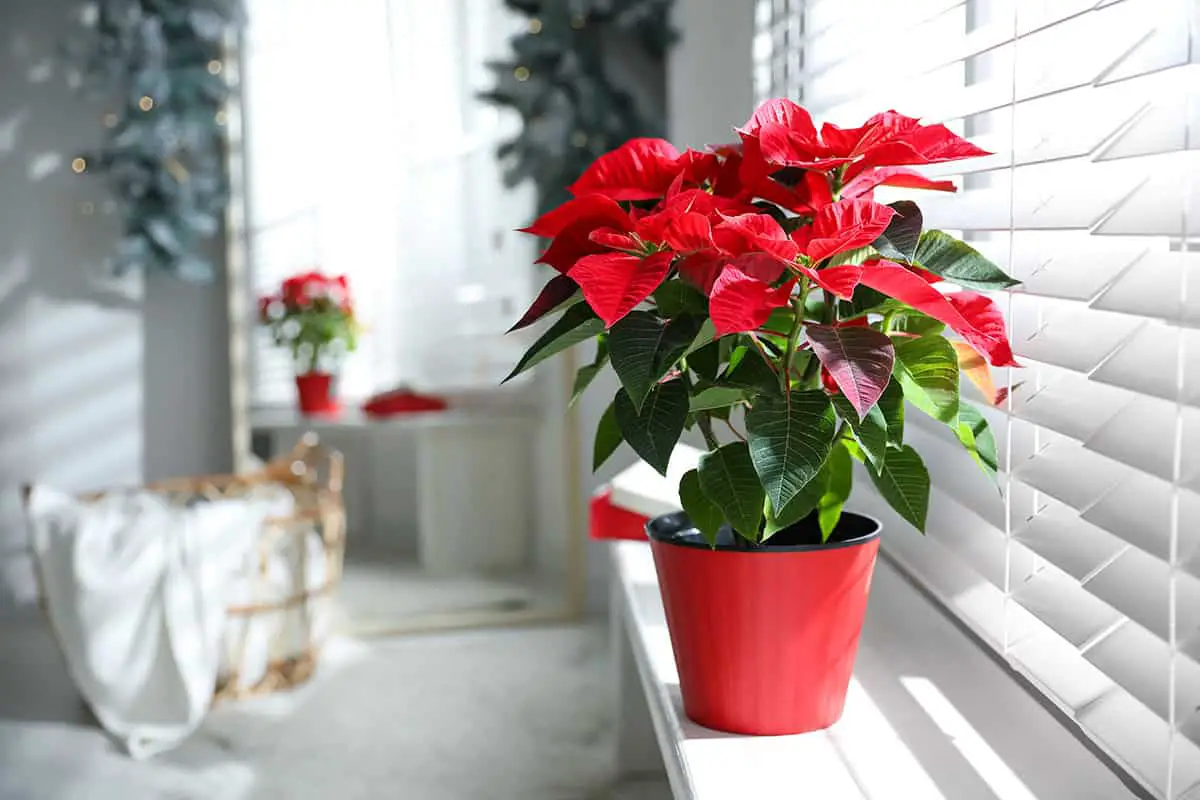
Poinsettias need bright light. Place your plant near a window receiving at least 6 hours of sunlight each day. If possible, choose an area with southern exposure.
Be mindful of the temperature, as poinsettias prefer temperatures between 60-70°F (16-21°C). Keep your plant away from cold drafts or extreme heat. Make sure the poinsettia’s leaves and flowers don’t touch the cold window glass, as cold contact may damage them.
Rotate your poinsettia regularly to ensure uniform growth. Doing so helps the plant receive sunlight on all sides. If you notice your poinsettia becoming leggy or stretching toward the light source, it signals the need for brighter light.
Soil
Poinsettias thrive in well-drained, organic-rich soil. Mixing peat moss or compost into your garden bed will create an optimal growing environment for the roots.
During repotting or transplanting, use quality potting soil. This type of soil is pasteurized to kill any diseases and can be found at garden stores and most box stores. Water the soil thoroughly after transplanting, ensuring water drains properly. Avoid overwatering to prevent soggy soil, as too much water can harm your poinsettia.
Taking care of your poinsettias requires monitoring and regular maintenance of the soil moisture, watering only when the top inch of soil feels dry. A quick tip to check soil dryness is to insert your finger 1 inch (2.5 cm) into the soil.
Watering
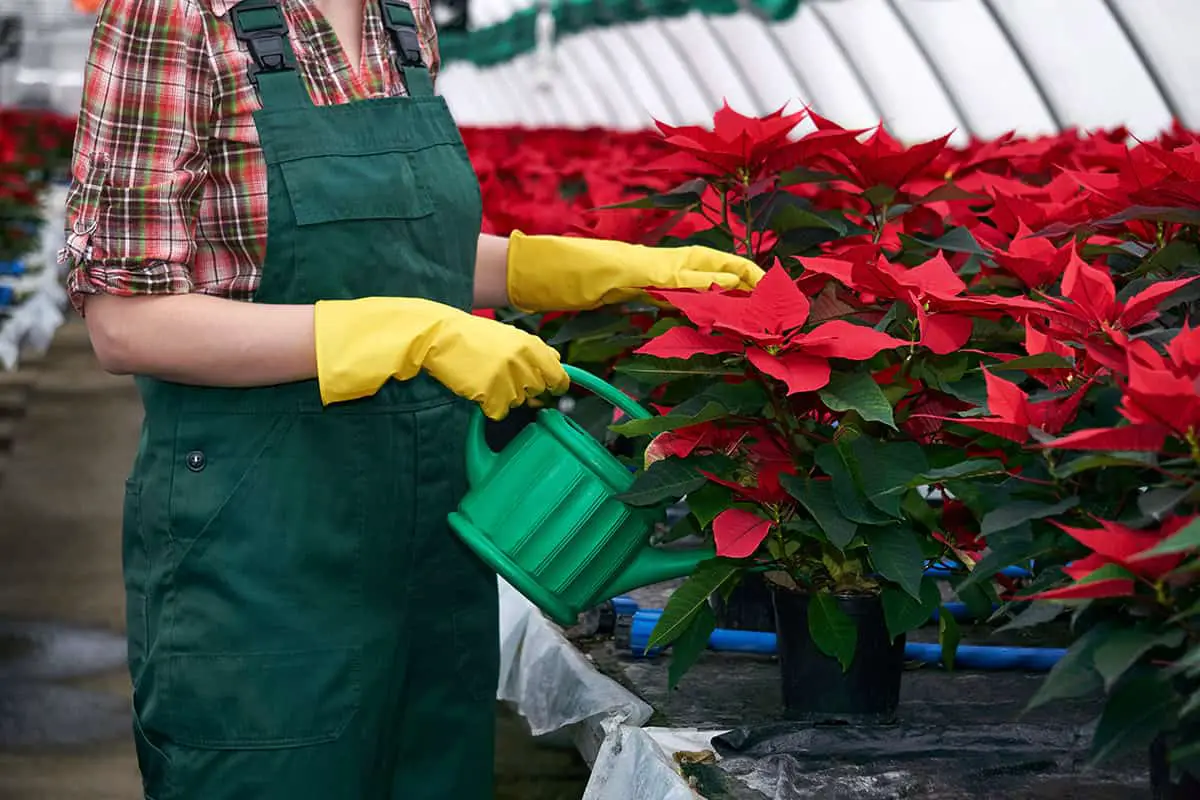
Your poinsettia needs proper watering to ensure lasting blooms. Water it when the soil surface is dry to the touch, but be careful not to let the soil become soggy, as too much water can harm your poinsettia.
Place a saucer under the pot to collect excess water, and remember to drain it if water starts accumulating. This will help maintain the ideal moisture level for your poinsettia. When watering, make sure you thoroughly hydrate the plant so that the roots can absorb the water they need for healthy growth.
During each stage of its growth, your poinsettia requires different watering frequencies. For instance, when new growth begins, it should be fertilized every two weeks with a water-soluble, complete fertilizer.
Temperature and Humidity
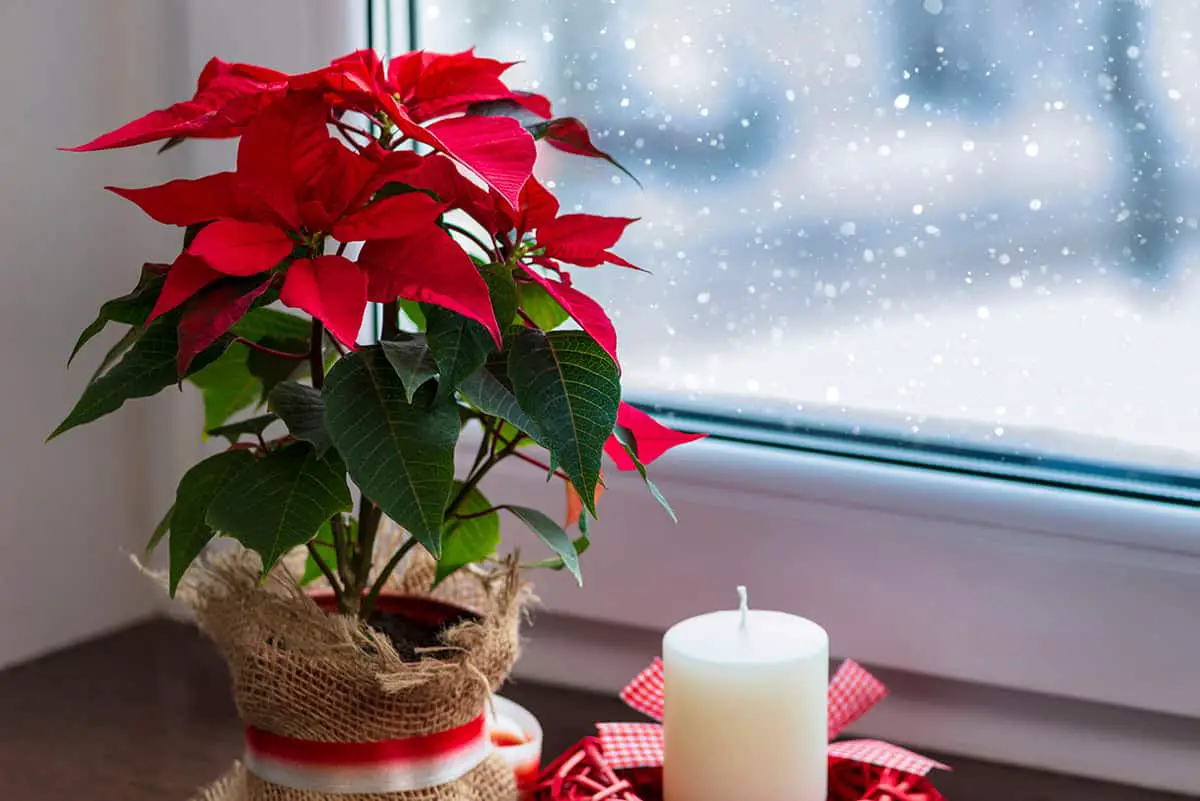
To ensure lasting blooms on your poinsettia, maintain ideal temperatures for the plant. Keep your poinsettia in an indoor environment with temperatures between 65 to 70 degrees F. Protect the plant from locations with fluctuating temperatures, such as near cold drafts, heat ducts, fireplaces, fans, or space heaters. It is essential to know that exposure to temperatures below 50 degrees F can cause damage and freezing conditions will kill poinsettias.
When it comes to humidity levels, you should provide your poinsettia with a well-balanced atmosphere. Too much humidity can cause the plant to wilt, while too little can dry out the foliage. Ensure your plant is placed near a bright window but avoid direct sun exposure or hot lighting, as these can dry out the plant.
Regularly assess the soil moisture to maintain optimal humidity. Water your poinsettia when the soil’s surface feels dry to the touch. Be cautious not to overwater, as soggy soil can be lethal to a poinsettia. When watering, place a saucer under the pot to catch excess water, and always remember to remove standing water from the saucer.
Fertilizer
Consider using the right fertilizer to ensure lasting blooms on your poinsettia. A common choice is a 15-0-15, 15-16-17, or 20-10-20 fertilizer. Remember that different fertilizer types can also work well for growing healthy plants.
During the initial stages of growth, it is best to fertilize your poinsettia every two weeks with a dilute fertilizer solution. This practice helps to stimulate growth and maintain the plant’s health. As you water, ensure that the soil remains moist but not soggy to avoid harming the plant.
When you notice new shoots, it’s time to cut the stems back and continue with your watering and fertilizing routine. As you progress with this regimen, be sure to periodically pinch the tips of the stems to encourage a bushier appearance.
Propagation

To propagate your poinsettia, start by selecting healthy stem cuttings from a mature plant. Look for stems that are 4-5 inches long with healthy leaves and no signs of damage or disease.
Next, prepare a well-drained, sterile potting mix and place the cutting into the soil. Make sure the lower leaves do not touch the soil surface to prevent rotting. Keep the soil moist, and cover the cutting with a clear plastic bag to maintain humidity. Place the cutting in an area with bright, indirect light and avoid direct sunlight.
Poinsettias root in two to four weeks. Once the cutting has formed roots, you can transplant it to a larger pot or into the ground. Place the young poinsettia in a location where it receives 4 to 5 hours of sunlight daily.
Pruning
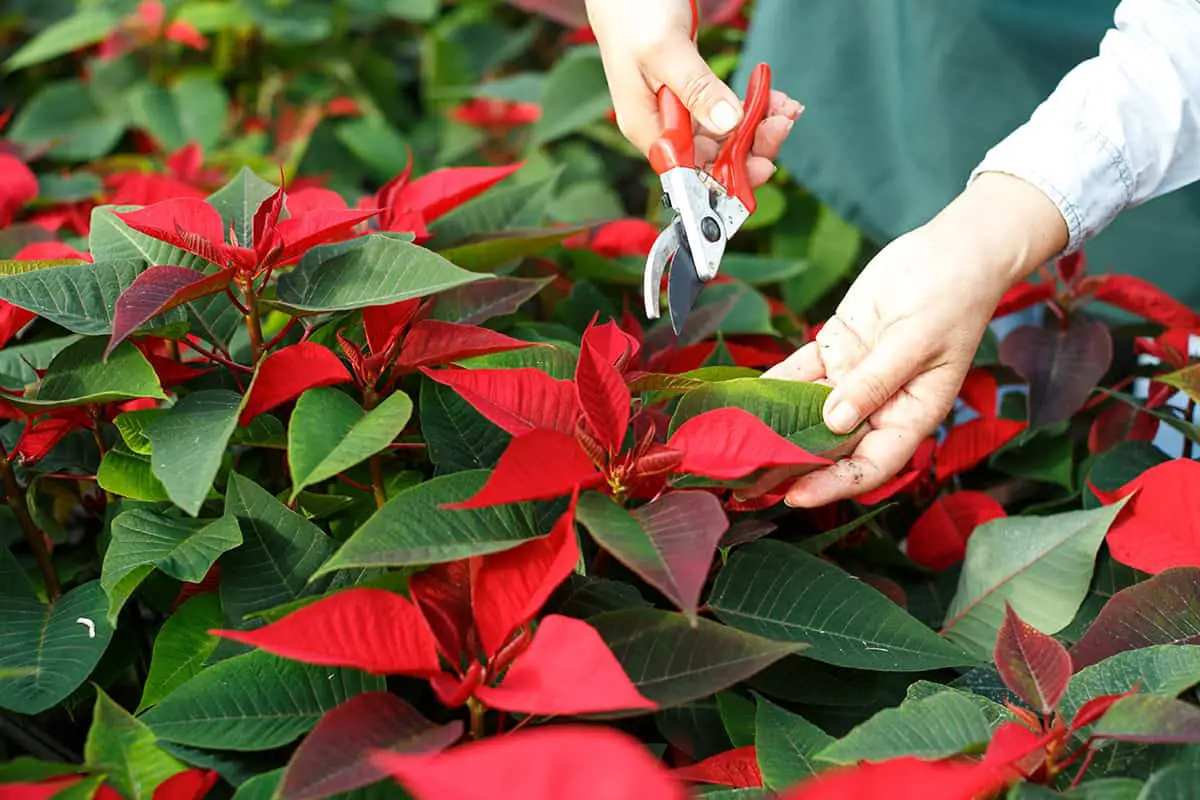
To ensure lasting blooms on your poinsettia plant, regular pruning is essential. Begin by removing any dead or damaged leaves to maintain a healthy appearance. Remember to always use clean, sharp pruning tools to avoid spreading disease.
After the blooming season, which typically ends in March, it’s time to give your poinsettia a proper trim. Cut back the stems to about 4-6 inches above the soil level. This encourages new growth and prepares the plant for its next blooming cycle. Make sure to wear gloves while pruning, as the plant’s sap may cause irritation to your skin.
When new growth appears in late spring, you can pinch back the tips of each stem. Pinching promotes bushier growth, resulting in a fuller plant.
As the winter holidays approach, pay close attention to your poinsettia’s light conditions. For the colorful bracts to develop, the plant requires long periods of darkness. Starting in October, place your plant in complete darkness for 12-14 hours each night, and give it plenty of bright, indirect sunlight during the day.
Potting and Repotting
After the holiday season, you might want to keep your poinsettia for lasting blooms. One critical step is to repot the plant in the spring. Ensure you select a larger pot than the current one and fill it with well-draining soil, as poinsettias require proper drainage to thrive.
Once you have found the right pot, it’s time to trim your poinsettia. Begin by cutting the plant back to about 6-8 inches in height. This ensures a bushier and more compact growth, especially when you pinch the new growth regularly. After all risk of frost is gone, place your repotted poinsettia outside in a partially sunny location that’s safe from strong winds.
Common Problems & Troubleshooting
Overwatering: Poinsettias don’t like soggy soil. Water your plant only when the top inch of soil feels dry. If your pot is wrapped in foil, poke holes in the bottom for excess water drainage. Keep an eye on the plant’s leaves – if they start to yellow and fall off, it may indicate excessive moisture.
Under-watering: On the other hand, underwatering can cause problems too. If the leaves of your poinsettia feel dry and brittle, it’s a sign you need to water more frequently. Like before, water only when the soil surface feels dry to the touch.
Poor lighting: Place your poinsettia near a bright window to ensure it gets adequate sunlight. Look for stretched or leaning stems, which can indicate insufficient light.
Temperature extremes: Keep poinsettias away from cold drafts or heat sources. Temperature fluctuations can cause leaf drop and poor blooming. Aim for a consistent temperature of around 65-75°F (18-24°C).
Diseases: Poinsettias are susceptible to various diseases, which can manifest as discolored or spotted leaves stem rot, or root decay. Maintain clean growing conditions, avoid overwatering, and use sterile propagation media to prevent disease issues.
How to Overwinter Poinsettia
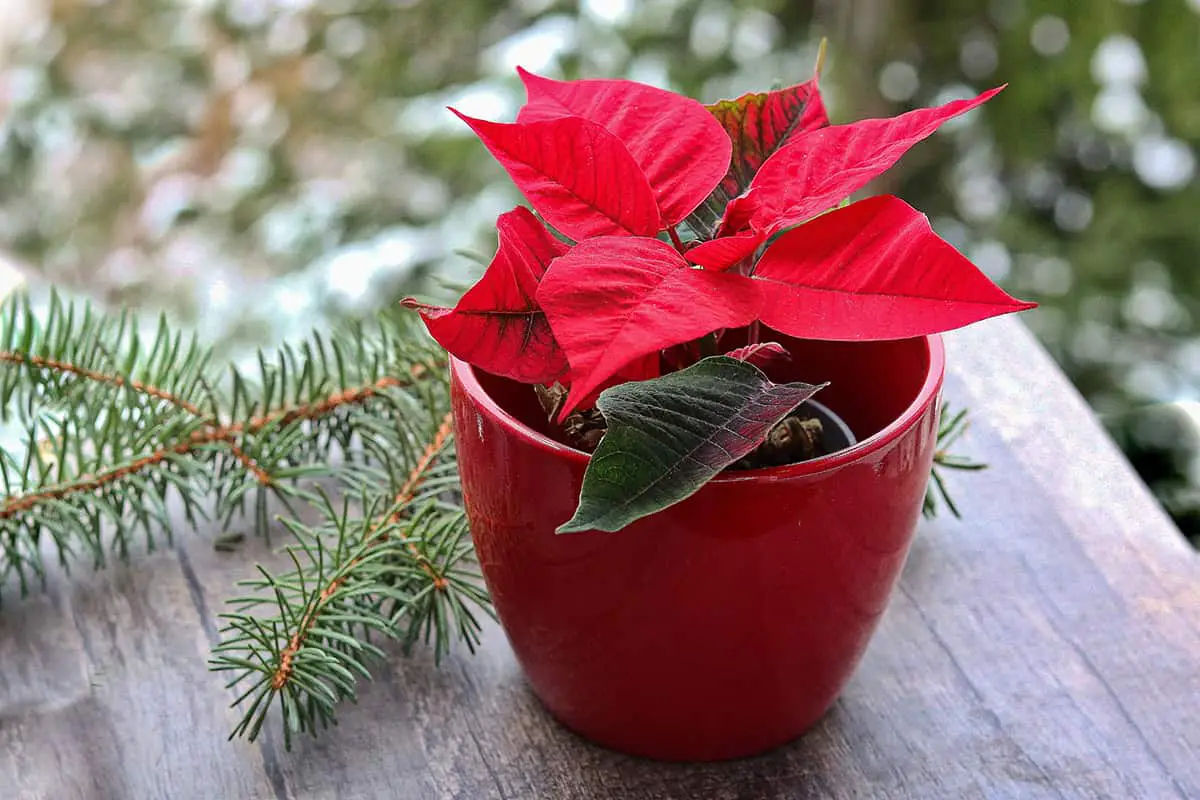
Once the festive season ends, you might wonder how to keep your poinsettia plant alive for future blooming. This section will guide you through the simple process of overwintering your poinsettia.
First, ensure your poinsettia receives plenty of indirect light. They thrive in well-lit areas, but direct sunlight can dry them up. At the same time, protect your plant from cold temperatures. Keep it away from cold windows and chilly drafts to maintain its health.
Water your poinsettia when the soil feels dry to the touch. You can place a saucer under the pot to collect excess water. Be sure to avoid letting the soil become soggy, as too much water can kill the plant.
As spring approaches, perform some pruning to stimulate growth. Cut back the stems to about 6 inches and ensure some leaves remain. Pinch the new shoots’ tips to make the plant bushier, and remove the very tip of the stem.
How to Make Poinsettia Bloom Again
Taking care of your poinsettia after the holiday season is key to ensuring a successful rebloom. Start by trimming the stems back to around six inches once the colorful bracts begin to fade . Make sure some leaves remain on the plant, as these are vital for new growth.
In early spring, after frost dangers have passed, consider repotting your poinsettia into a larger container. Move it outdoors to a spot with partial sun and protection from strong winds. Regularly pinch the new growth to keep your plant bushy and compact.
During the growing season, make sure your poinsettia gets 6 to 8 hours of sunlight outdoors. This exposure helps to maintain its health and promote growth. Fertilize your poinsettia with a water-soluble, complete formula every two weeks . Remember to water the plant thoroughly, ensuring the soil stays moist but not soggy.
When it’s time to move your poinsettia back inside, typically around October, place it near a sunny window. To encourage blooming, your poinsettia requires a consistent dark period for at least 14 hours a day.
To achieve this, cover the plant with a box or a dark cloth during the evening, and ensure it gets 8 to 10 hours of light during the daytime. Repeat this process for around 6 to 8 weeks, and your poinsettia should start to develop beautiful, colorful bracts once again.
